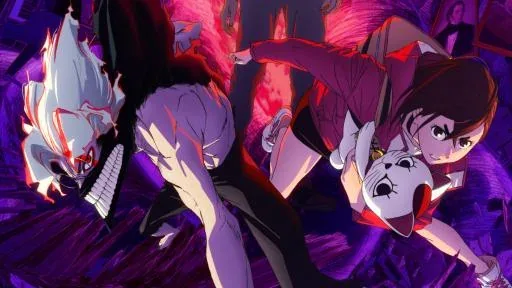Dandadan Season 2 Episode 6 delivered another masterclass in balancing supernatural chaos with genuine emotional depth. Titled “We Became a Family,” this latest installment from Science SARU perfectly captures Yukinobu Tatsu’s unique blend of horror, comedy, and heart. Released on August 8, 2025, the episode showcases why this anime adaptation continues to exceed fan expectations through its exceptional attention to character details and tonal control.
Table of Contents
Dandadan Season 2 Episode 6: Essential Details
| Aspect | Details |
|---|---|
| Episode Title | “We Became a Family” |
| Release Date | August 8, 2025 (12:26 AM JST) |
| Studio | Science SARU |
| Director | Fuga Yamashiro |
| Key Focus | Evil Eye’s integration, Jiji’s character development |
| Major Scenes | HAYASii band exorcism, maid café comedy |
| Streaming | Crunchyroll, Netflix, Hulu |
| Episode Length | 24 minutes |
| Next Episode | August 15, 2025 |
Evil Eye Possession and Family Bonds
Episode 6 opens with the Evil Eye taking complete possession of Jiji, resulting in chaos as Okarun faces attack and Momo’s house suffers destruction. However, Momo’s quick thinking with hot water snaps Jiji back to reality, highlighting the practical solutions that make Dandadan so endearing.

The HAYASii Band Exorcism
The arrival of the spiritual rock band HAYASii brings one of the episode’s most visually striking sequences. Their special brand of spiritually attuned music creates a vibrant exorcism scene filled with energy and color, demonstrating Science SARU’s exceptional ability to blend supernatural elements with contemporary culture.
The band’s music possesses the unique power to reach spirits without causing harm to themselves, creating a spectacular audio-visual experience that perfectly captures the manga’s kinetic energy.
Seiko’s Compassionate Decision
The episode’s emotional core emerges when Jiji pleads for the Evil Eye’s acceptance, revealing the spirit’s lonely childhood and desperate desire for friendship. Seiko’s uncharacteristic empathy leads to a pivotal decision that defines the episode’s title theme.
Building a Chosen Family
Instead of proceeding with the exorcism, Seiko stops the ritual and welcomes the Evil Eye into their “family.” This decision showcases the series’ consistent theme of finding belonging in unexpected places, with Okarun promising to protect Jiji and grow stronger to handle any future possessions.
For more anime reviews and seasonal coverage, explore our comprehensive entertainment analysis at TechnoSports Entertainment.
Momo’s Maid Café Adventures
The episode’s second half shifts to lighter territory as Momo begins working at a maid café to repair the house damage. This comedic segment demonstrates Science SARU’s mastery of tonal transitions, seamlessly moving from supernatural drama to slice-of-life humor.
Character Development Through Comedy
Okarun’s embarrassed reaction to seeing Momo in her maid uniform provides authentic character moments that deepen their relationship dynamics. These seemingly throwaway scenes serve multiple purposes: advancing character relationships, providing comic relief, and expanding the world beyond supernatural encounters.

Science SARU’s Animation Excellence
Visual Storytelling Mastery
The studio’s attention to small details shines throughout the episode. Every character movement, facial expression, and background element serves a purpose in building the world’s authenticity. Science SARU expands brief manga moments into fully realized scenes that add personality and warmth.
Tonal Balance Achievement
What sets this episode apart is its exceptional tonal control. The adaptation never forgets that heart and humor aren’t opposites—they enhance each other. Even during over-the-top comedy sequences, the emotional grounding remains intact, creating a viewing experience that feels organic rather than jarring.
Stay updated on the latest anime releases and industry news at TechnoSports.
Technical and Artistic Highlights
Color Psychology and Visual Flow
The episode demonstrates sophisticated use of color transitions between comedic and dramatic beats. Each scene maintains distinct visual personality while contributing to the episode’s overall rhythm, showcasing the animation team’s understanding of visual storytelling principles.
Character Animation Details
Background usage, particularly scenes featuring characters against expansive skies or cityscapes, reinforces thematic elements about individual connections within larger contexts. These visual metaphors provide depth without drawing excessive attention to themselves.
Why Episode 6 Succeeds
The episode succeeds by trusting small moments to breathe and develop naturally. While some might argue these additions don’t advance the plot significantly, they create a lived-in world that feels authentic and inhabited by real personalities rather than mere plot devices.
Emotional Authenticity
Science SARU understands that Dandadan’s greatest strength lies in the spaces between its chaos—those quiet moments where characters connect, struggle, and grow. This episode solidifies that approach by allowing emotional beats to develop alongside supernatural action.
Watch Dandadan Season 2 on Crunchyroll, Netflix, and Hulu. Follow the series updates on MyAnimeList and check Science SARU’s latest work on IMDb.
Frequently Asked Questions
Q1: What makes Dandadan Season 2 Episode 6 stand out from previous episodes?
A: Episode 6 excels in its perfect balance of supernatural action and emotional depth. The episode’s title “We Became a Family” reflects its core theme of acceptance, as Seiko decides to welcome the Evil Eye into their family rather than exorcise it. Science SARU’s attention to character details, combined with the HAYASii band’s visually stunning exorcism scene and Momo’s maid café comedy, creates a viewing experience that feels both kinetic and heartfelt.
Q2: How does Science SARU’s animation enhance the source material in this episode?
A: Science SARU elevates Yukinobu Tatsu’s manga through exceptional attention to small details that manga panels can’t fully capture. The studio expands brief moments into fully realized scenes, using color psychology to transition between comedy and drama, and trusting quiet character moments to develop naturally. Their tonal control ensures that emotional authenticity remains intact even during over-the-top comedy sequences, creating depth that surpasses mere faithful adaptation.








